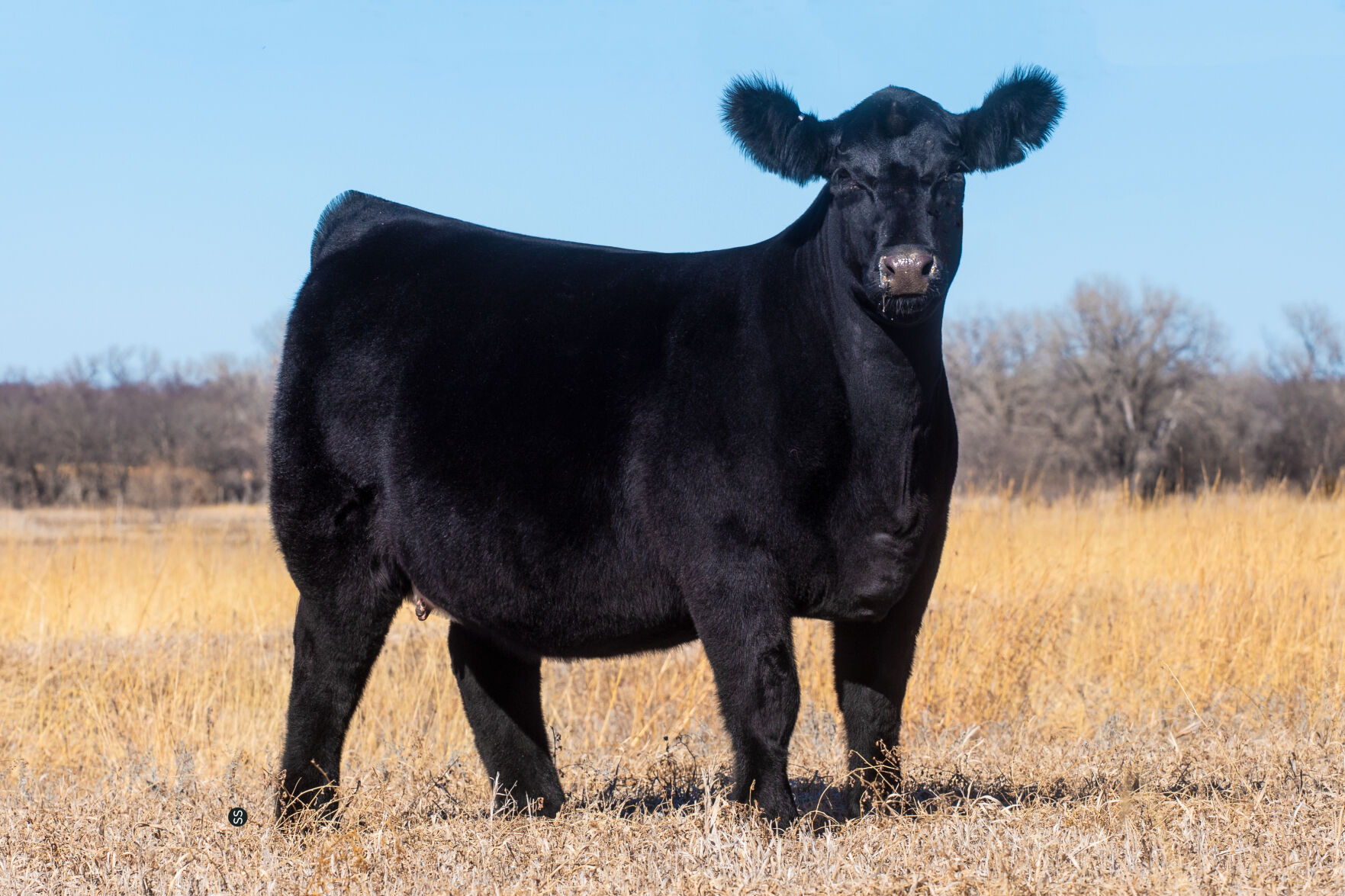Data matters: In cattle genetics, details pay dividends

To earn a premium a cattleman has to pay attention to every detail when evaluating genetics.
Information is more readily available than it once was, according to Dave Nichols, of Nichols Farms, Bridgewater, Iowa. He recalled a time when the sharing of important traits was difficult, but producers learned that doing so led to nurturing the industry that is the standard for the rest of world.
As a youth he could remember sage advice from his dad, Merrill, who told a young Nichols to take a sire group of three bulls to a Central Bull Test Station and pay attention to the entries by his competitors. His dad told Dave to “buy the ones that beat you” as a way to improve their seedstock. “Use competition to make improvement not to just have a ribbon on the wall. All we were doing then we were measuring growth.”
Today, there are many more ways for a producer to improve his stock.
Weaning weight and yearling weight are the biggest genetic traits that have progressed the most in the past 50 years, Nichols said. “What we are measuring is the pay weight of the calves off the cow.”
Information needs to be followed throughout the process from birth as producers evaluate their stock’s rate of gain until the animals are processed, he said.
As a result, weaning weight and yearling weight are what have become obvious cornerstones in a breeding program for the producers to measure their calves. Performance bull tests have also became the norm. The capability to share information has helped improve the genetics pool, Nichols said. Numerous breed associations have stepped up to help producers.
Ultimately the goal of producers should be to provide consumers with beef that is a nutritious source of protein and with quality products that can provide a value regardless of socio-economic level, Nichols said. He has championed the value of the study of beef genetics to reach that goal. He was a pioneer in the Beef Improvement Federation that was formed in 1968, serving on its first board of directors and later as president.
Today he likes the focus on maternal instincts and birth weights. He remembered a time when a 1,000- to 1,100-pound cow could not handle a 100-pound birth weight calf. That led to the development of ratios and expected progeny differences to help producers with birth weights and calving ease. Also, calving intervals became essential, particularly for cow-calf operators.
“A 2-year-old heifer does not make you any money until her third calf,” Nichols said.
Longevity also is key. Two groups he has ties with, the American Simmental Association and American Angus Association, have whole herd reporting, which can provide critical information to help cattlemen in their decision-making process.
Nichols Farms collects more than 70 objective data points on each animal, creating a database that has been the basis of countless genetic research projects. Nichols was also a pioneer in the transition of Simmental to black-hided and polled cattle instead of the traditional color pattern. Through his service on the National Cattlemen’s Beef Association, Nichols played a critical role in the development and implementation of instrument carcass grading. Overall, it was through the efforts of Nichols, and the small group of other performance pioneers, that the industry switched from the show ring to performance testing as the primary means of selection.
Nichols also notes there are timeless tips that make a difference for producer. Nichols remembered advice his dad gave to him in pointing to a sign by a scale as his dad reiterated, “Weight times the money,” Dave Nichols said. “If you are doing anything that detracts from that goal, you are probably making a mistake.”
Think long term
Regardless of the current climate, a producer has to think and plan in the long term, said Rick Pfortmiller, of Natoma, Kansas, a beef genomics territory manager with Neogen and a manager on the family’s commercial cow-calf operation where he and his wife and daughters now live as the fourth and fifth generations on the land. They manage the family’s commercial cow-calf operation using Simmental x Red Angus genetics selected for low input environments.
Producers continue to be on an adoption curve and in many ways this generation of producers are using more sophisticated technology to help manage genomic traits as they look for ways to improve their herd, Pfortmiller said. Those opportunities are becoming more readily available and user friendly for livestock producers to acquire the information they need to succeed.
“The first unsung hero in this whole genomics world both from seedstock and the commercial side is the ability to assign parentage,” Pfortmiller said. “The product heritage is one of the answers that we can provide on our commercial heifer testing platform and it is included in the price. It is so interesting that when the heifers come out of either a multi-sire situation that is often the column they go to first to see who the sire is.
“There is real opportunity I call it the gateway drug to genomics,” he said. “Even if they are thinking about doing genomic testing at a commercial ranch level when you have the sires, let’s collect the samples because we can always link. You never know when you’ll get some calves that fall short of expectations maybe because of birthweight, performance or genetic defects.”
Sign up for HPJ Insights
Our weekly newsletter delivers the latest news straight to your inbox including breaking news, our exclusive columns and much more.
Parentage can help answer many questions, he said, and while it is true that a producer does not need to use technology to be a successful rancher or cattle producer there are tools to provide risk management, Pfortmiller said. Each producer has a different value and “it is the value of time you are risking.”
If he buys a bull and produces a couple of sick calves he might chalk that off as anomaly, but if the next time the same problem occurs the producer has to ask himself if I turn him out again and the same thing occurs then is it a lost opportunity. Genomic testing can identify traits, he said.
The same holds true for commercial heifers in projecting maternal instincts.
Two 600-pound heifers can look alike but Pfortmiller notes that without a genomic profile if one was genetically different than other the producer could pick the wrong one and face not only an immediate loss but a lost opportunity, too.
If she comes up open, he said, that is a lost opportunity, too.
“Our tests are only for genetic potential,” Pfortmiller said, adding the producer still has to manage, feed and provide appropriate medical care. “I want a heifer that I know will contribute in the long term rather than have one that just might.”
The more information available can help mitigate risk, he said.
Breakthroughs
Breakthroughs have had a large impact on genetic evaluations on beef cattle, said Professor Matt Spangler, an Extension beef genetics specialist with the University of Nebraska-Lincoln, as he noted two important ones.
The initial development of the mixed model equation by Charles Henderson that could provide statistics for the EPDs that producers use today was one of the breakthroughs.
“This is but one example of the close relationship that the fields of statistics and genetics have,” Spangler said.
The other breakthrough was the sequencing of the bovine genome and subsequent development of single nucleotide polymorphism “chips,” which enabled genomic prediction and the ability to increase the accuracy of EPDs.
The traits that a producer focuses on are completely dependent on his breeding objective, Spangler said. A breeding objective identifies goals and constraints of an operation and can help identify the traits that are economically relevant and deserve attention.
For example, if a producer retains his own replacement females, then traits such as heifer pregnancy and sustained cow fertility or stayability are important, he said. If a producer identifies retained ownership, the post-weaning gain, feed intake and carcass characteristics also become important.
Producers need to have a well-thought-out plan and be willing to stick with it, Spangler said.
“Breeding cattle takes long-term planning, particularly if replacement females are retained,” Spangler said. “The goals of an operation should not change overnight and certainly should not change given market fluctuations in a single year.”
Genetic selection decisions to reduce cost can be beneficial, too, he said.
“Selection decisions overall should focus on improving net profit, which requires a constant focus on both revenue and cost,” Spangler said.
Improved sustained fertility is important if replacement females are retained and calving ease is important if bulls are exposed to heifers, he said.
There are three major mistakes a producers can make in evaluating traits:
1. Not using EPD and instead using actual (or adjusted) measurements or relying on visual inspection without care for genetic potential;
2. Not having a well-informed breeding objective that directs the producer to the traits he needs to focus on; and
3. Incorrectly using any form of birth weight data (including birth weight EPD) when calving ease EPD exists.
Total maternal calving ease is an underrated trait, he said.
“If producers keep back replacements they should pay attention to this,” Spangler said. “I would say sustained cow fertility and stayability are also often overlooked.”
Spangler advises producers to use economic indexes to simplify sire selection decisions and to select bulls based on net profit potential to their operation.
A good resource that producers might find helpful is www.ebeef.org.
Back to the future
Pfortmiller believes that genomic traits and technology will continue to evolve. Farmers and ranchers who are also grain producers who have worked with genetics to address droughts and insect pressure have tended to be the early adopters of genomic testing and trait studies, he said. He reiterates that ultimately the livestock producers have to make the decision on stock they are going to keep in the operation or cull.
Nichols notes that as he learned from entering competitions as a youth in 4-H and FFA programs, it is important to make a good decision based on sound information rather than solely focusing on instincts and intuition. Making rational reasons and being able to communicate that to others remains timeless.
Nichols believes that principle. He noted about four to five years ago as he toured a Kansas feedlot and he saw that 25% of stock in the feedyards appeared to be Holsteins. It was a time when beef cattle were selling at such a premium that it was unaffordable for low- to middle-income families. Nichols told the feedlot operator that he was thankful he was thinking outside the box because the future of the beef industry depends on a plentiful supply so that all households can share the nutrition and enjoy the quality of beef. Consumers, he said, understand the value and versatility of beef.
“The worst thing that can happen to the beef industry is that its products become a specialty meat,” he said.
The study and implementation of genetics plays an important part in making the equation successful, he said.
Dave Bergmeier can be reached at 620-227-1822 or [email protected].


